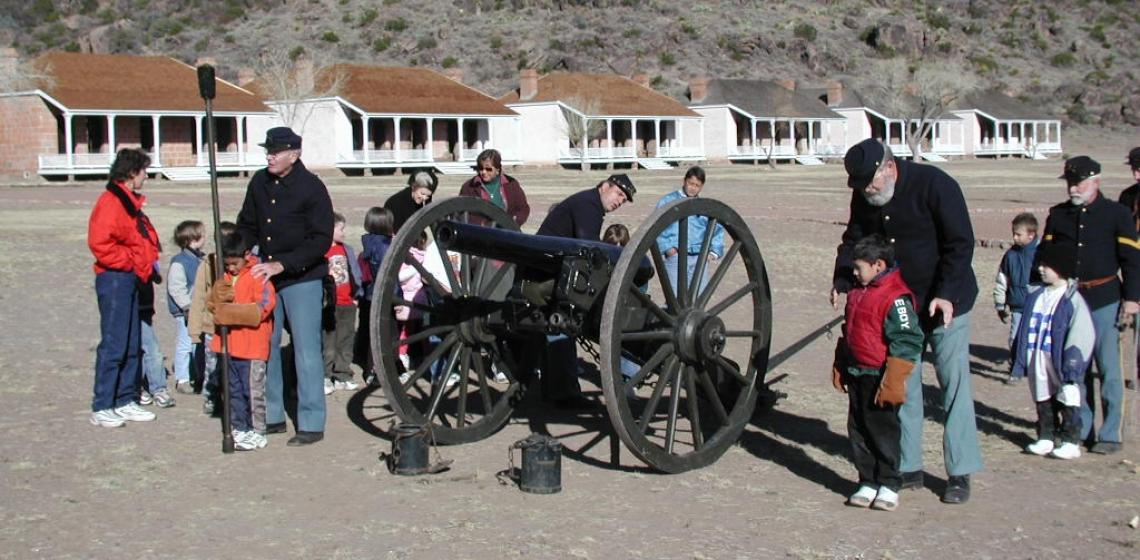Fort Davis National Historic Site (US)

A key post in the defence system of west Texas, Fort Davis played a major role in the history of the Southwest. From 1854 until 1891, troops stationed at the post protected emigrants, freighters, mail coaches, and travellers on the San Antonio-El Paso Road. Today Fort Davis is one of the best remaining examples of a frontier military post. It is a vivid reminder of the significant role played by the military in the settlement and development of the western frontier...
The fort was established on the eastern side of the Davis Mountains, in a box canyon near Limpia Creek, where wood, water, and grass were plentiful. It consisted of primitive structures and was located behind the present-day Officers’ Row. (The foundations of several buildings from this earlier fort can still be seen today.) From 1854 to 1861, troops of the Eighth Infantry spent much of their time in the field pursuing Comanches, Kiowas, and Apaches who attacked travellers and mail stations.
With the onset of the Civil War and Texas’s secession from the Union, the federal government evacuated Fort Davis. The fort was occupied by Confederate troops from spring 1861 until the summer of 1862 when Union forces again took possession. They quickly abandoned the post, and Fort Davis lay deserted for the next five years.
Few of the fort’s structures remained when Lt. Col. Wesley Merritt and four companies of the newly organized Ninth US Cavalry reoccupied Fort Davis in June 1867. The building of a new post, just east of the original site, began immediately. Fort Davis’s primary role of safeguarding the west Texas frontier against the Comanches and Apaches continued until 1881. Although the Comanches were defeated in the mid-1870s, the Apaches continued to make travel on the San Antonio-El Paso Road dangerous. In June 1891, as a result of the army’s efforts to consolidate its frontier garrisons, Fort Davis was ordered abandoned, having “outlived its usefulness.”
About nine buildings are reconstructed, including the lieutenants' quarters, the commanding officer's quarters, several barracks, the commissary and a granary. During times of peak visitation, rangers and volunteers dressed in period type clothing present programs and interpret some of the restored and refurnished quarters.
Enlisted Men’s Barracks
The south end of this restored barracks has cavalry, infantry, artillery, and transportation exhibits. The north end has a squad room and an orderly room. It offers a glimpse of summer 1884, when it was occupied by Buffalo Soldiers of Troop H, Tenth Cavalry. Iron bunks, footlockers, carbine racks, clothing, and accoutrements in the squad room help to tell the story of the men who served here. The orderly room was the office for the troop’s first sergeant.
Commissary
This large building on the San Antonio–El Paso Road held the garrison food supplies. Enlisted men had rations, but officers and civilian workers could buy food products at cost plus the transportation. The commissary sergeant’s office and the issue room are refurnished. The office occupied by the Acting Commissary of Subsistence (officer in charge of the commissary office) has interpretive exhibits.
Officer’s Kitchen and Servant’s Quarters
This two-room refurnished building was the kitchen and servants’ quarters for that Officer’s Quarters. It was separate from the main house mostly because of fire danger. Extreme summer heat and unpleasant cooking odours were factors as well.
Post Hospital
With a second ward added in 1884, the post hospital could accommodate up to 24 patients. It was normally staffed by a post surgeon, hospital steward, soldier nurses, a cook or cooks, and a matron. The post surgeon rarely performed surgery.
Soldiers suffered mainly from diseases and accidental injuries, not battle wounds. The building has a central walkway with interpretive signs and interactive exhibits.
The Commanding Officer’s Quarters
Constructed by 1869, this building served as the residence for post commanders until 1891. Because of the extensive documentation available on Col. Benjamin H. Grierson, Tenth Cavalry, and his family, the quarters is furnished to the period 1882–85, when the colonel was post commander.
Shared Lieutenants’ Quarters
This structure was built for a captain in May 1882, but, because of a housing shortage, it was soon designated a shared quarters. It is refurbished as if a bachelor lieutenant lived in the north side and a married lieutenant in the south side.
Main text source: Fort Davis National Historic Site PR material.
Image: Friends of Fort Davis National Historic Site
